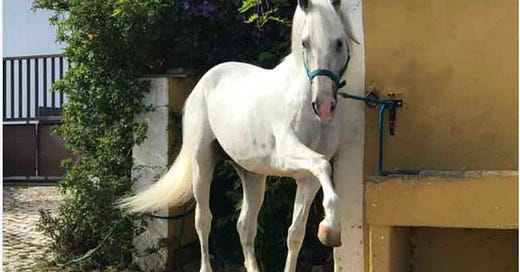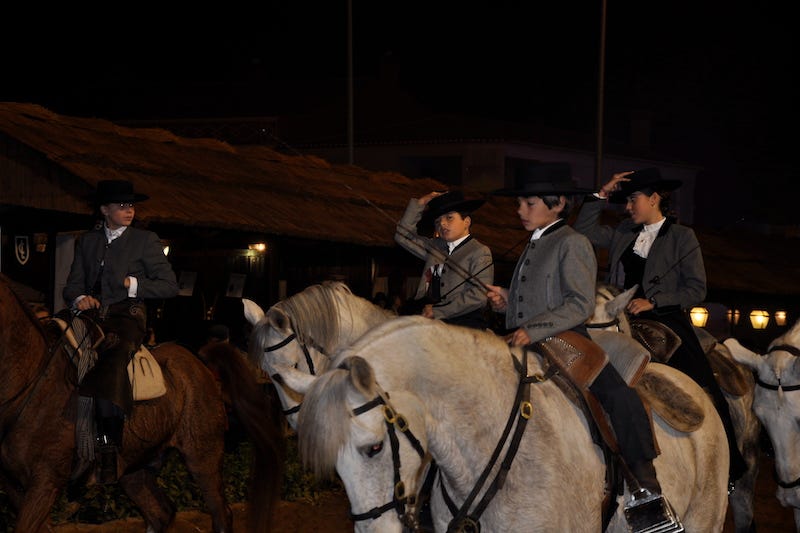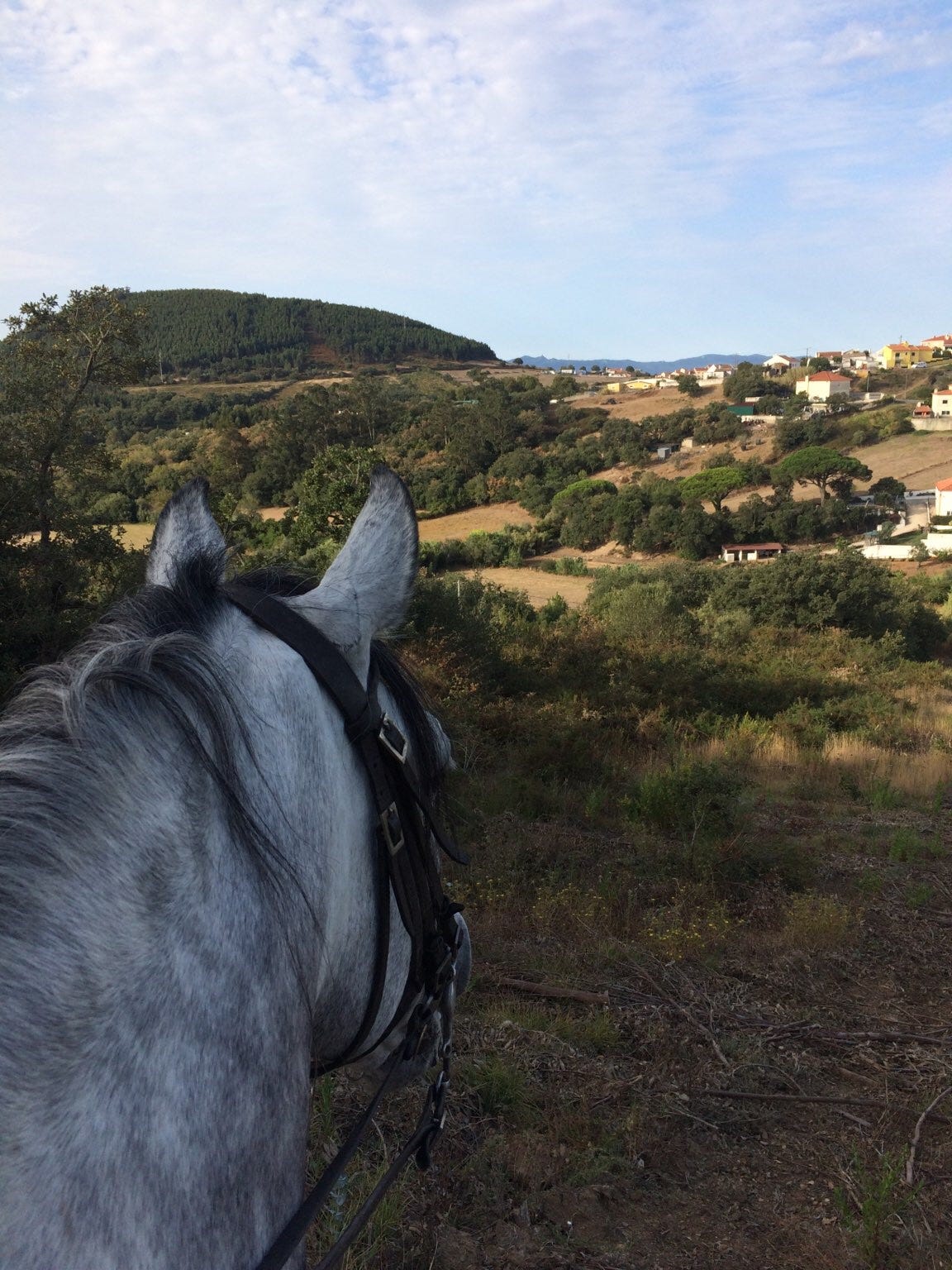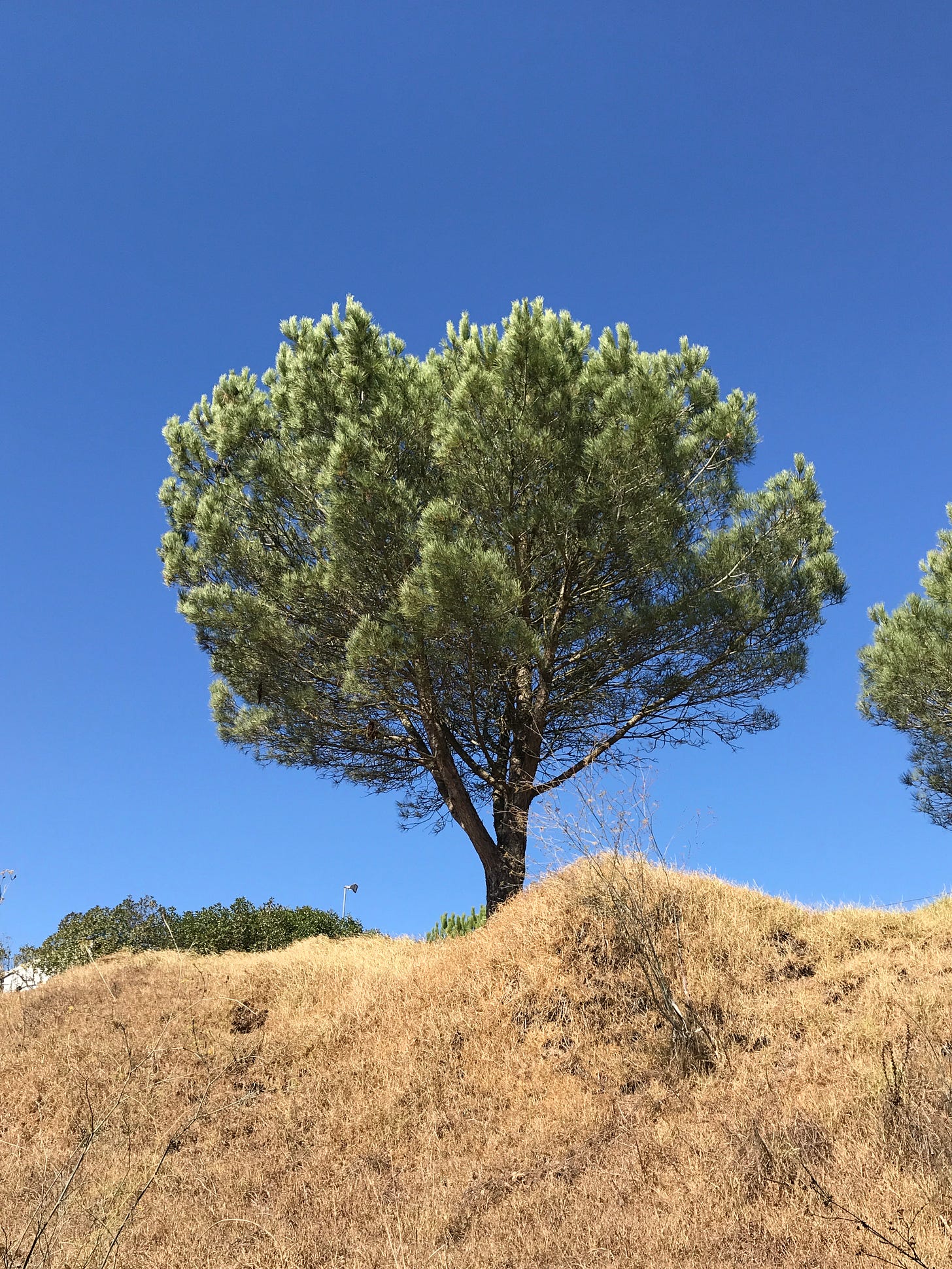Lucky Lusitano
Beautiful things and pleasures of the flesh in the in-between region of Portugal
By Caroline Smrstik
In Portugal, everything slows down. Whether in the city or the country, it’s a courtly kind of slowing down. No pressure. And not the indolent sort of mañana tempo one tends to find in a larger Iberian country. Portugal is steadfast.
In the spring, the hills north of Lisbon are impossibly green. It’s always damp, all year round. The sunny days and the wind that fuels the windmills will dry anything hanging outdoors quickly, but should one miss the right moment to bring in the laundry, jackets, shoes—hopeless. The damp sinks in and one must wait for another round of sun and wind.
On the drive from the airport, the radio is tuned to a Sunday nostalgia program of Amália Rodrigues’ greatest hits and the reinha do fado lulling me around the highway’s curves. Blue, white, green, yellow: sky, clouds and windmills, hills, houses, home soon.
Rolling back the gate to the quinta, the dogs greet me, rolling over one another, and the horses murmur and whinny, curious heads peeking over stall doors, ears perked, nostrils flaring. I can’t unpack the apples and carrots fast enough.
Even the most robust Lusitano stallions are gentlemen, though.
Perceves at first sight
The first time I visited Portugal had nothing to do with why I return, or perhaps it did. I was in love. The Doctor-Engineer was presenting at a hydropower conference in Lisbon, and my schedule allowed me to join him. For the first and only time in my life, I signed up for the “accompanying persons program,” which allowed me to be shuttled around with wives to visit the fairytale palaces in Sintra, or look over the shoulder of traditional ceramic artists, or spend an afternoon tasting port. I saw the Doctor-Engineer in the evenings, when we attended magnificent conference dinners: a pull-out-all-the-stops leitão evening out in the country, where the roasted suckling pig melted in our mouths, and a gala banquet in the National Coach Museum in Belém. The baroque splendor of the horse-drawn carriage collection was almost too much, but the location, an old royal riding school, reminded me of Vienna and warmed my Habsburgian soul.
Once conferential duties were finished, the Doctor-Engineer and I stayed on in Lisbon. It was 1998; the Expo was on, and we had a lot to explore. One afternoon we were swooning through the Bairro Alto in Lisbon, as young lovers do, when we decided to step into one of the city’s traditional cervejarias. Calling such a genteel dining room a beer hall is misplaced. It was comfortably cool and dark. We ordered a vinho verde and a huge prato de marisco and leaned back to study the tiled arches of this pleasant cavern. In time, a magnificent platter arrived, reminiscent of a 16th century still life. The sight lives on in my memory.
A pile of blackish-purple clawed things were tucked between the sea snails and the prawns. Hoping for clues, we scanned the tools we received, but saw no special implements. We tucked into the delights we could identify, while eyeing the mystery creatures. A garnish? They looked like an exotic seaweed, with dark tentacles flowering into stony tips. Our combined sea experience covered the Mediterranean and the US Atlantic coast, the Caribbean and the Gulf of Mexico, the North Sea and the Baltic—but never had we encountered such things.
Two ladies d’un certain age sat at the next table, gossiping their way through a late lunch, clearly Old Lisbon to judge by their jewelry and exquisitely handmade leather shoes. They noticed our consternation and the way we avoided the creatures from outer space that had mistakenly landed on our seafood platter.
“Excuse me, may I help you?” inquired one gently in charmingly formal Portuguese. Using scraps of Italian-accented Portuguese and French, we communicated in halting pantomime. The ladies laughed merrily. The creatures, we came to understand, were called perceves. They grew on the rocky north Atlantic coast and were quite edible. Like most delicacies from the sea, it’s a bit of work to get to the good part (think oysters, or lobster) and not at all obvious how to attack. No tools are of help: It’s finger food.
Mimicking the chuckling ladies’ gestures, we separated one leathery finger from its rocky base, pinched just below the claw, and twisted. Lo, the leathery skin slipped off. We were left holding the claw with a strip of violet flesh hanging from it. Perceves have a clam-like, chewy texture and taste of pure, cold, salty, rock-bashing sea waves. The ladies applauded “bem faito!” and appeared to take as much pleasure in our discovery as we did.
I later learned that in English, perceves are called goose barnacles, possibly for their long neck and beaky claw. They grow only on rocks in an intertidal zone, as one finds in Galicia, because they need moving water to feed. Unlike oysters, perceves cannot be farmed. Fearless percebieros harvest them, working in pairs at low tide. Like an alpinist in a wetsuit, one percebiero sets his rope atop a rocky coastal cliff, then rappels down to wrench off chunks of barnacles with a tire iron as the icy waves bombard him. When the net sack at his belt is full, he scampers up the jagged, wet surface to take up the lookout post while his partner descends. The fattest, most flavorful—and thus most expensive—perceves are the ones farthest down the cliff. Do the mollusks taste even better for the death-defying feats required to bring them to my table? Of course.
Golegã galanterie
My next Portuguese adventure was in 2003, this time with a friend from the stable who had just purchased a young Lusitano stallion. Four keen equestriennes set off for a few days of horse ogling, wine drinking, visiting a horse festival, a few riding lessons, and more wine drinking. It was the beginning of a subtle indoctrination.
We drove through the dark for hours, over poorly lit and narrow roads, to Alpalhão, nearly on the Spanish border. The next day, we stomped through muddy fields to seek out the prized stallion baby. Once found, we performed a baptism of sorts with a bottle of Prosecco brought for the purpose, then joined the breeder and about forty of his closest friends for lunch at the local restaurant. It went on for hours. I remember huge plates of deliciousness, conversation in French with ridiculously chivalrous Portuguese country gents, and a lot of wine.
“Of course you are going to Golegã for the weekend,” insisted one. “Your first time?”
My wide-eyed “oui” was met with shouts of enthusiasm from around the table.
The Feira da Golegã is a horse fair held in the small Alentejo town of the same name. The spectacle takes place over ten days every November, when the village’s human population of just over 5,000 is completely outnumbered by Lusitanos. The Lusitano is an Iberian breed, unjustly in the shadow of the better-known Andalusian. They used to be the same, sharing a stud book until 1966. But the Spanish capitalized on the movie-star allure of the noble war horses, while the Portuguese optimized the Iberian horse’s classical features. With five stallions and one mare as founding stock, the Portuguese horse was thereafter known as the Lusitano, from the Roman Lusitania, as the region was called.
Since then, strict rules on breeding and registry have consolidated and preserved the Iberian horse’s best traits. Even Portugal’s turbulent twentieth-century politics—including the breaking up of agricultural estates in the Ribatejo and Alentejo regions during the Carnation Revolution in the mid-1970s—failed to dilute the bloodline and the meticulous registry. The muscular Lusitanos are supreme athletes, with elegant, smooth, forward movement. But they are also working horses, calm and sensible, whose agility makes them perfect for gineta: work with cattle, bullfighting, combat, hunting. In Portuguese bullfighting, not incidentally, the bull is not killed, and it’s a great dishonor for a horse to be injured. The spectacle is an intricate dance between horse and bull, rider and horse.
Lusitanos also excel in the other dancing-horse sport: Their elegance, high-jointed movement, and intelligence predestines them for high-level dressage. The Portuguese even founded their own royal riding school in 1989, featuring specially bred bay horses. They train and perform just like the Vienna Spanish Riding School with its Lipizzaners, or France’s Cadre Noir in Saumur.
For the normal mortal rider, the Lusitano is a partner for life. They love to learn, are concentrated and generous in spirit, and for all their strength and passion are ridiculously gentle beasts. If this is in fact in their genes, the Portuguese have done brilliantly in less than a century. Rumor holds that the Spanish Andalusian breeding association has on several occasions suggested remerging the stud books, but the Portuguese have always politely declined. Some say it’s because the Andalusians have been watered down by indiscriminate breeding; others say Portugal wants to keep its own place on the equine map. It seems very Portuguese: quietly going about their business, inescapably proud, yet modest.
At Golegã, it’s easy to fall under the spell of these magnificent beasts. During the festival, the town square is transformed into a huge arena for demonstrations of working equitation and dressage, competitions, and presentations of horses to be judged on their perfection as breeding stock. The track around the square, the manga, is for the informal show, a round-the-clock parade of mounted men, women, and children in traditional dress, horses groomed until they glow. The next ring is made up of wooden pavilions, where Lusitano breeders and their guests have the best view of the goings-on. Imagine box seats and an endless supply of wine, local cheese and olives, thin-sliced Iberian ham, and gossip. The safest way to move around town is on a horse. There are horse-drawn carriages that carry those who, for some reason—elderly, newborn, or exceedingly drunk—cannot ride. Pedestrians tend to be tourists, breeders, or those who are only temporarily not on a horse.
When night falls and traffic on the manga increases, it’s a terribly romantic scene. Everyone cuts a fine figure in the Portuguese formal riding habit, with its waist-length, close-fitting jackets and waistcoats for men and women, long slim trousers for the men, and split skirts for the women. The dark blue, brown, or grey wool is broken with a bit of brocade here or passementerie there, and the women often wear their jackets open to show off a matching corset or a cascading white lace collar. The dark wool bolero hat with its broad brim sits at the perfect angle for its wearer to make every glance seem flirtatious.
As the smoke from the braziers of the roasted chestnut sellers drifts across the manga, the transformation into a late nineteenth-century fair is complete. It is not just the horses who are judged here on their lines and potential for breeding. Groups of young men and young women circle and circle, to see and be seen. A solo artist makes sure to gather his mount into an impressive piaffe, dancing in place for a few long minutes where he catches the eye of … whom? A breeder, a buyer, or the girl in the dove-grey riding habit?
Despite the crowds and the way no one seems to be concentrating on their horse’s behavior, chaos never breaks out. Small children are swung up to sit behind mama, or papa, or grandfather for a round or two, perched on the fox-skin xairel behind the saddle.
The harmony and elegance of horse and rider is incomparable. We four equestriennes, observing the spectacle in our borrowed finery, are intimidated by the intuitive horsemanship on display. But after enough wine, our jaws stop dropping at every casual canter pirouette. We relax into the atmosphere. All these straight-backed men with their easy smiles and flashing dark eyes—and their horses! I start practicing my glances from beneath my hat brim, just in case.
Suddenly, it’s my turn. The groom and trainer we had come to meet are waiting at the corner entrance with two Lusitanos—one huge, muscular, and grey; the other a smaller bay; both braided and polished, the ornaments on their old-fashioned bridles gleaming. I opted for the bay, and off we went. Two rounds of the manta later, I still felt like I was driving an unfamiliar rental car on the wrong side of the road. I was almost relieved to surrender my mount to the next eager equestrienne. She returned white-faced and white-knuckled after one lap.
Clearly more wine was in order. Desperate to feel the magic I saw around me, I agreed to take the bay for another spin, this time accompanied by the trainer on the other horse. He conversed with me as if we weren’t trying to guide two gigantic horses through an obstacle course of frisky stallions and drunken speeding carriages. He made exceptionally polite small talk—he was pleased to make my acquaintance, was this my first time in Portugal, had I met Antonio yet, surely I’d sampled the chestnuts?—without saying a word about what I was doing or not doing with this horse. When he suggested we trot a bit, it was the most natural thing in the world.
“Ah, collect him a little, that’s it, relax your hands,” he said. And I felt it: the power and elegance of this horse moving under me. My back straightened, automatically, and I grinned, utterly forgetting any mysterious glances. Now I was moving at eye level with all these riders I had been admiring, and not a few of them grinned right back at me, registering my delight. I’ve returned again and again, always working to capture that floating feeling of oneness. It’s beautiful work, resulting in achy muscles, a head full of images, a soul full of peace.
The quinta where the horses live is nestled in the Estramadura, the in-between region of Portugal—to the west an abrupt stop at the Atlantic, to the east trickling off into the wide plains of the Ribatejo and Alentejo. Lisbon is in the Estramadura; but away from the city, the in-betweenness of the region draws me, spectacular in its ordinariness. The hills fold into one another, dotted with windmills, and the pace of village life is still set by the older women who walk past the washing place, with its blue and white tiles, on their way to church. Behind the quinta are hills; beyond that, the tapada, the royal hunting ground and park created by João V, Portugal’s Sun King, in the first half of the eighteenth century.
When I head for the very western edge of the Continent, I go to Ericeira. When I’m over the last windmill-peaked hill and I see the ocean glistening ahead, I catch my breath. Every single time, at the same place in the road. Suddenly, the horizon. There’s none of the traffic and the touristy crowds of Cascais or Estoril, and none of the elegant villas either. Just narrow cobbled streets with blue and white houses, two main pedestrian streets, some surfing wear shops, a huge old grand hotel perched on the stones at water’s edge. Elderly couples stroll under the plane trees in the main square; families eat ice cream; toddlers chase birds.
Below the town, small coves offer some protection from the wind on the beach—a year-round fascination, moody and misty in the winter. In the spring, stone gardens along the long stairway back to town erupt into blossoms, white, pink, and blue. There are always people on the beach—meandering walkers, couples huddled in blankets or picnicking between sheltering stones, solitary readers soaking up rays of November sunshine. Even at the height of summer, there’s space. Portuguese surfers mix with families; there is no bikini défilée. Children and adults explore the tidepools, and if it’s a really hot day, they wade in, up to the knee. The water is bracing, exhilarating, and best appreciated while wearing neoprene.
I dream of a plate of perceves, still warm from their steamer, with fresh bread and salted butter, a platter of sliced tomatoes and lettuce, clams cooked in white wine with giant smashed garlic cloves, olive oil, fresh coriander, a half-bottle of vinho verde. I walk into a simple seafood restaurant on the very western edge of Europe, sit down at one of the four tables, and say, “The usual, please.”
Talk at the lunch table turned again to horses. I was the only one in the room without a Lusitano. “We need to find a horse for you,” insisted a regular, in a tone that suggested it had become her personal project. Everyone laughed. She persisted. “What are you looking for?” All eyes were on me.
“A friend,” I answered.
I had never thought very hard about it, aside from vaguely thinking I prefer larger ones. But color, age, sex, training, personality, any special features? My eager intermediaries awaited my verdict, but I was stumped.
Years passed. Whenever the Doctor-Engineer noticed I was short-tempered, he’d tell me to go to Portugal. So I did, fine-tuning the harmony between my body and mind, taught different lessons by a series of brilliant Lusitano schoolmasters. Each time I fell into the rhythm faster, and the love of the action became a love of the place.
The foals born every spring at the quinta are proof of the breeder’s years of experience in judging a horse’s character. It is a small, family-owned operation. Each little jewel is welcomed with joy and raised with love. I watched them grow into gentle, elegant riding horses who, one after another, found a home with someone selected, just as carefully, for her ability to provide the loving care and upbringing that such an animal deserves. It’s a long-term partnership. Lusitanos mature slowly. They aren’t introduced to work under saddle until they’re fully grown. Their intelligence and temperament allows them to quickly learn the basics and enjoy learning. Bred for robustness, twenty-year-old Lusitanos are still spirited, happy to show off their paces.
One blustery November, when I despaired of ever getting the damp out of my belongings, the trainer and breeder brought his crop of foals in from the field, eager to show them off. He introduced the little graphite-colored colts, each peeking his nose above the stall door. “This one is the shyest of the three,” he said. “This one is already sold. And this one—he’s a mover.”
The Mover was not shy. While the other two went back into hiding, he stood and looked at us, expectantly. I laughed at him. He tilted his head slightly and kept looking. As casually as possible, I asked the trainer to let me know when he took the Mover out to let him have some exercise on the lunge line.
That afternoon, we walked the Mover out to the ring. His initial skepticism about having this halter thing put over his head dissipated quickly, though he danced about and called his mates, as an eight-month-old foal is apt to do. And then: This little snip of a thing proceeded to trot and canter in the circle as though he’d done it a hundred times before. The brief moment when all four hooves seemed above ground, as if his long spindly legs were spring-mounted, was a promise of what might become. All the power and elegance of the Lusitano was plain to see. As we brought him back to his stall, to the great relief of his abandoned half-brothers, he popped his head over the door again with an expression that read, unmistakably, “How was I?”
The Mover was not only beautiful, he was funny. I was clearly done for.
My visits now have an extra purpose. The spindly colt has filled out nicely, and his coat has already started to lighten. A lifetime of white hairs stuck to everything awaits me. He’s big, at 15.2 hands already, and far from finished; he’ll top out easily over 16 hands. He’s learned what carrots are, and apples. We hang out, go for walks, and discover the world together. He’s curious, still not one bit shy, and learning that when I’m with him, he needn’t be afraid of suspicious things, like falling blocks of wood. He is mannerly, apart from his current stroppy teenager phase, and silly, and still floats on air when he moves.
The Doctor-Engineer hasn’t met the object of my affections yet, but he marvels appropriately at the video updates I receive regularly.
Now, when I arrive at the quinta, once I’ve greeted the dogs and horses and people, I go for a walk down the road heading out of the village until I get to the field where the teenage boy gang is at play. I clamber over and through the gate and watch the three stallions at the far end. Then I call. Three sets of ears perk up, but only one comes trotting over to where I stand. My heart swells.
Caroline Smrstik Gentner was born and educated in the United States, worked as a foreign correspondent in Central and Eastern Europe, and now lives in Switzerland. She is the founder and owner of Smrstik Communications: “Only the name is complicated.”









Gorgeous. Thank you for sharing this!